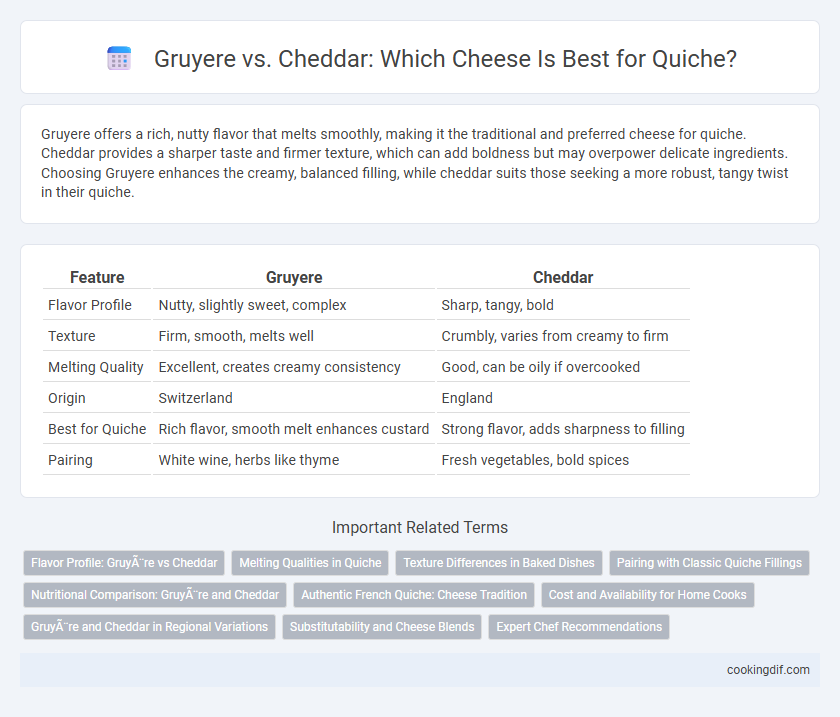Gruyere offers a rich, nutty flavor that melts smoothly, making it the traditional and preferred cheese for quiche. Cheddar provides a sharper taste and firmer texture, which can add boldness but may overpower delicate ingredients. Choosing Gruyere enhances the creamy, balanced filling, while cheddar suits those seeking a more robust, tangy twist in their quiche.
Table of Comparison
| Feature | Gruyere | Cheddar |
|---|---|---|
| Flavor Profile | Nutty, slightly sweet, complex | Sharp, tangy, bold |
| Texture | Firm, smooth, melts well | Crumbly, varies from creamy to firm |
| Melting Quality | Excellent, creates creamy consistency | Good, can be oily if overcooked |
| Origin | Switzerland | England |
| Best for Quiche | Rich flavor, smooth melt enhances custard | Strong flavor, adds sharpness to filling |
| Pairing | White wine, herbs like thyme | Fresh vegetables, bold spices |
Flavor Profile: Gruyère vs Cheddar
Gruyere offers a rich, nutty flavor with a slightly sweet undertone, making it ideal for a classic quiche recipe that requires smooth melting cheese. Cheddar delivers a sharper, more tangy taste with a pronounced bite, contributing a bold and robust character to the dish. The choice between Gruyere and cheddar significantly impacts the flavor depth and overall taste experience of the quiche.
Melting Qualities in Quiche
Gruyere offers superior melting qualities in quiche, creating a smooth, creamy texture without becoming greasy or oily. Cheddar melts well but can separate and release oils when baked, potentially affecting the custard consistency. For a perfectly cohesive quiche filling, Gruyere's balanced meltability and mild nutty flavor make it the preferred cheese choice.
Texture Differences in Baked Dishes
Gruyere cheese offers a smooth, creamy texture that melts uniformly, creating a rich and velvety consistency ideal for quiche fillings. Cheddar tends to become oilier and crumbly when baked, resulting in a sharper texture that may alter the custard's smoothness. Selecting Gruyere enhances the quiche's silky mouthfeel, while cheddar provides a firmer, more rustic bite.
Pairing with Classic Quiche Fillings
Gruyere enhances classic quiche fillings such as spinach, mushrooms, and leeks with its nutty, slightly sweet flavor that melts smoothly into the custard base. Cheddar offers a sharper, more robust taste, ideal for quiches with stronger fillings like bacon or caramelized onions, creating a bold contrast. Both cheeses melt well but provide distinct flavor profiles that elevate traditional quiche combinations depending on the desired taste intensity.
Nutritional Comparison: Gruyère and Cheddar
Gruyere cheese contains approximately 413 calories per 100 grams, providing 29 grams of protein and 33 grams of fat, rich in calcium and vitamin A. Cheddar offers slightly higher calories at around 403 per 100 grams, with 25 grams of protein and 33 grams of fat, also packed with calcium and vitamin D. Both cheeses contribute significant nutrients for quiche, but Gruyere offers a richer protein content, while Cheddar provides more vitamin D.
Authentic French Quiche: Cheese Tradition
Gruyere cheese embodies the authentic French quiche tradition with its slightly nutty and creamy texture, offering a smooth melt that complements the delicate custard base perfectly. Cheddar, while flavorful and sharp, diverges from classic recipes by introducing a more robust taste and firmer texture that can overpower the subtlety of traditional quiche. Selecting Gruyere preserves the historic cheese heritage integral to French quiche, ensuring an authentic flavor profile and optimal texture.
Cost and Availability for Home Cooks
Gruyere is often pricier and less readily available in regular supermarkets compared to cheddar, making cheddar a more budget-friendly and accessible choice for home cooks. Cheddar's widespread availability in various sharpness levels allows for flexible flavor profiles without increasing costs significantly. Opting for cheddar can simplify ingredient sourcing while maintaining a deliciously cheesy quiche.
Gruyère and Cheddar in Regional Variations
Gruyere, a Swiss cheese, is prized in quiche recipes for its nutty, slightly salty flavor and excellent melting properties, contributing to a rich, creamy texture. Cheddar, originating from England, offers a sharper, more pronounced taste and tends to create a denser filling, preferred in some British and American quiche variations. Regional preferences dictate the cheese choice: French quiches often highlight Gruyere for authenticity, while Cheddar is favored in Anglo-American adaptations for its bold flavor.
Substitutability and Cheese Blends
Gruyere and cheddar both serve as popular cheese options in quiche recipes, with Gruyere prized for its rich, nutty flavor and smooth melting properties, while cheddar offers a sharper taste and firmer texture. These cheeses can be substituted based on desired flavor profiles, though combining Gruyere and cheddar in blends enhances complexity and balances creaminess with tanginess. Such cheese blends improve the overall texture and depth of quiche, catering to diverse palate preferences.
Expert Chef Recommendations
Expert chefs recommend Gruyere over cheddar for quiche due to its superior melting qualities and nutty, slightly sweet flavor that complements eggs and cream without overpowering. Gruyere provides a smooth, creamy texture that enhances the quiche's custard base, while cheddar's sharper, more aggressive taste can dominate the dish. Renowned culinary professionals often favor Gruyere for classic quiche recipes to achieve an authentic, balanced flavor profile.
Gruyère vs cheddar for cheese selection Infographic

 cookingdif.com
cookingdif.com